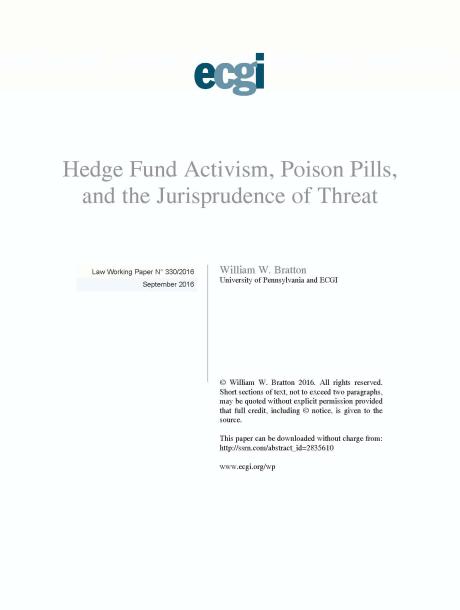
Hedge Fund Activism, Poison Pills, and the Jurisprudence of Threat
Abstract
This chapter reviews the single high profile case in which twentieth century antitakeover law has come to bear on management defense against a twenty-first century activist challenge?the Delaware Court of Chancery?s decision to sustain a low-threshold poison pill deployed against an activist in Third Point LLC v. Ruprecht. The decision implicated an important policy question: whether a twentieth century doctrine keyed to hostile takeovers and control transfers appropriately can be brought to bear in a twenty-first century governance context in which the challenger eschews control transfer and instead makes aggressive use of the shareholder franchise. Resolution of the question entails evaluation of the gravity of two sets of threats, one at the doctrinal level and the other at the policy level. The doctrinal threats are exterior threats to corporate policy and effectiveness on which managers justify defensive tactics under Unocal v. Mesa Petroleum Co. Because some threats have greater justificatory salience under Unocal than do others, a question arises as to the nature and characterization of the threats allegedly held out by activist intervention. The policy threats implicate the new balance of power between managers and shareholders. The chapter appraises the threats. As regards Unocal, it demonstrates a serious problem of fit. The chapter goes on to conduct a thought experiment that reshapes and extends Unocal so that it does provide a robust basis for sustaining management defense against activist hedge funds, even shielding poison pills with 5 percent triggers. The extension amounts to radical reformulation of the conceptual framework of corporate law, thereby posing the policy threat. But the policy threat, on examination, proves uncompelling, today?s corporate managers being disinclined to traverse shareholder preferences by promulgating standing poison pills. Given that, the chapter asks whether 5 percent poison pills could hold out policy benefits in the form of company-by-company shareholder-manager engagement on the question of suitability for activist intervention.









